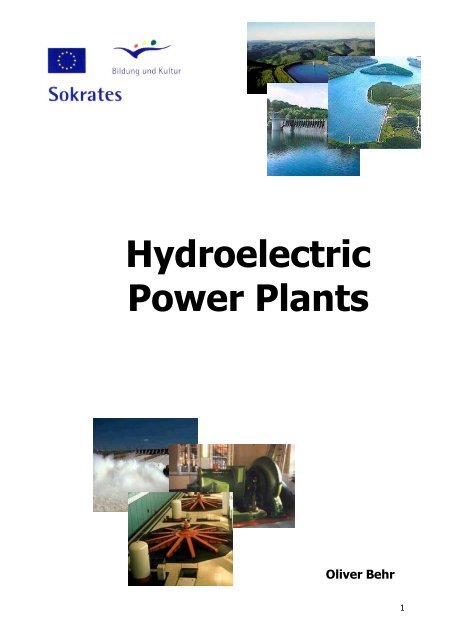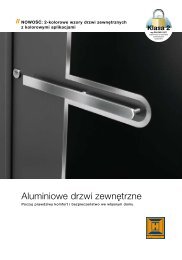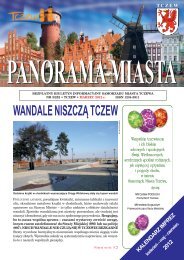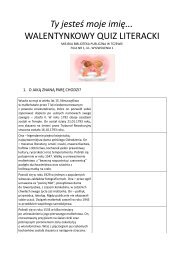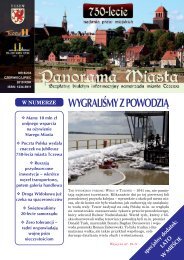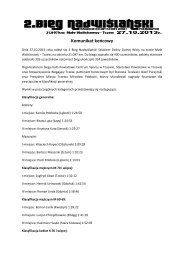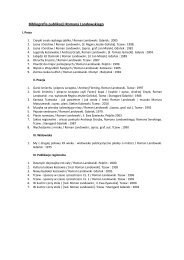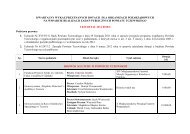Hydroelectric Power Plants
Hydroelectric Power Plants
Hydroelectric Power Plants
Create successful ePaper yourself
Turn your PDF publications into a flip-book with our unique Google optimized e-Paper software.
<strong>Hydroelectric</strong><strong>Power</strong> <strong>Plants</strong>Oliver Behr1
Table of content:•Introduction•History of hydropower•Hydropower today•Advantage and disadvantage of a hydroelectric power plant•Different hydroelectric power plants•Different turbines•<strong>Hydroelectric</strong> power plants of Weilburg•Water power of the Westerwald•SourcesIntroduction:Water power belongs to the oldest energy sources of mankind. For centuries itwas used as an energy to run mills, hammer works, sawmills and similar plants.Today the power of the rivers and dams is used mainly for the generation ofelectrical power.Water power has a portion of 4,3% in Germany produced by 660 hydro-electricpower plants in the entire republic.It is the mostly used regenerative energy source (it has a portion of 85 % ofthe regenerative energy sources).Apart from the energy conversion the artificial lakes are used also for drinkingwater storage, irrigation and flood protection.History:The enormous forces of water was already known by the Persian and theChinese in the antiquity. In the 3 rd century B.C. the Romans transfered theenergy of the horizontal water wheels over gear wheels to a vertical wheel.There were two types of water wheels. One dipped perpendicularly into thewater and was propelled over a water inlet from above. The other water wheeldips with its lowest part into the flowing water. The weight of the waterbrought the wheels in motion. 100 B.C. the Greeks used water power to propelmills. A water jet was derived from a river, which turned an upright standingwheel. The wheel was connected with a crankshaft, which moved the millstone.But only 1000 A.C. this knowledge came to remaining part of Europe. For over700 years factories, sawmills and paper mills worked with water power onbrooks and rivers. In 17 th century a large water wheel from wood was created,which furnished a maximum achievement of approximately 37 kilowatts.Modern water power owes its development to the English civil engineer JohnSmeaton, who built as first large water wheels from cast irons. Dams andchannels needed one over with downward gradients of more than five metersseveral water wheels to build one behind the other. The building of large plantsat dams was not yet possible in the beginning 19 th century. Low water levelsduring summer and in the autumn led - in connection with frost in winter - tothe replacement of nearly all water wheels by steam plants.2
The first hydroelectric power plants for power generation were established 1880in England. The water power was rediscovered around the turn of the century,when American engineers coupled a water turbine with an electrical generator.The water meets the impellers of a turbine, which begins to turn. Thus thegenerator is activated, which functions like a bicycle direct current generator.Also the larger demand for electric power played a role. With the discovery ofthe "direct current generator-electrical principle" by Werner von Siemens 1866the foundation-stone for the generation of current from water power was laid.Today:Today water power is considered as one of the most pollution free energysources.The technology did not change at the beginning of the 20 th century.Flowing water in rivers follows the force of gravity. At natural water falls or atartificial waterfalls, the energy of the water goes to the generators, which arepropelled by turbines, and is converted into electricity current.In thermal power stations water is heated up burning fossil fuels (or by nuclearfission processes) to high temperatures, water vapour (steam) is led onturbines, which propel generators and produce also electricity. In allhydroelectric power plants it is basically water, whether in liquid or gaseousform, which propels the turbines. Contrary to storage plants, which aredependent on back-ups of large quantities of water, there are a few examples,where both of the downward gradient and of the constant flow rate of waterare sufficient to maintain hydro-electric power plants. Such a power station isthe most common plant of the USA and Canada (e.g Niagara Falls).Everywhere in the world today you can find hydroelectric power plants. Thelargest was built in Africa and Latin America.In Itaipu/ Brasilien there is the largest hydroelectric power plant of the world.It can produce up to 12600 Megawatts. The dam is 17 km long and up to 196meters high. It became inaugurated in 1982 and 42.000 people had to leavetheir homeland. 146000 hectare of rainforest of the Amazon area drowned inthe water.In November 1997 China started to build one of the largest dam of the world.Until the year 2009 the Jangze River should be hold back on a length of 660kilometres. The power station should produce 18200 megawatts.Advantage:Advantage and disadvantage of ahydroelectric power plantWe have a very large problem in this world, because we need al lot of electricalcurrent at certain times. We do not have a current storage; therefore we needpower stations with which are able to produce a constant power and some whocan produce power for peak-times. So hydroelectric power plants are veryuseful.Pump-fed power station that are built next to an artificial lake, and you canstart it very fast.3
Other power stations such as nuclear power stations or wind power stations arenot so flexible in their production of current, the wind power station is totalllydependent on nature's forces.By current production from water we do not harm the environment, because noexhaust gases become free here (no emission).Disadvantage:We can build these water companies only in certain places cause of thedownward gradient, that is needed for it , or a lake, in addition to discharge thewater. Which speaks much against a hydroelectric power plant because it takesup very much space which on ther other hand may already be used by peopleor may have other ecological or industrial advantages.AdvantageDisadvantage-Pollution free, there are no pollutants - comparatively high investments- no consumption of natural resources - frequently large distances betweenfavourable water power locations andconsumer centres- small delivery of warmth - Energy production is inconsistent withwave power stations in open sea- high efficiency (about 90%) - Over congestion of otherwise usablesurfaces and ecologically valuable habitats- long life span of a plant - sociological effects due to resettling- simple and proven technology - Interruption and restriction of the habitatfor moving fish- low operating cost due to small - Disturbance of the water regime in therequirements at maintenance and environmentoperation- Speed of employing and turning a plantoff- Advantages during general-purpose use(irrigation, navigation, flood protection,potable water supply)- Reduction of the velocity of flow, whichleads demolition of the area above thewater thus retaining structure to depositsand below to the erosion- Disturbance of the habitat of manyanimals species living in the water and planttypes- Energy storage possibility - Water changes occur how: Oxygenpoverty, temperature change, change of theflow conditions and increase in nutrients tooinadvertent plant growth-Elevation of the ground-water level- No flooding – no fertile mud distribution- Disturbance of the biological equilibrium4
Different hydroelectric power plantsPattern of a pump-fed power stationThere are different kinds of hydroelectric power plants,that all have differences in their design:• constant flow hydro-electric power plant• Storage power station• Pump-fed power station• Tidal power station• Glacier power station• Wave power stationThe constant flowhydroelectric power plantis the simplest kind ofhydroelectric power plants. Itfunctions after the old way.For this one needs water anda water wheel, this isaccelerated by the water isthus propelled. The Thecompany brings constantpower into the net. It runs 24hours a day.The disadvantage of thisplant is that the speed of thewheel cannot be adjusted.5
The storage power station is operatedwith an artificial lake. You decidebetween daily, monthly and yearlystorage. These plants are used at thepeak times. One can make certainadjustment here and produce thus atcertain times more energy.One can also prevent floods, storedrinking and irrigation water. This takesvery much space and this is a very largedisadvantage.The pump-fed power stationserves the stabilization of thepower-net and as reserve work, ifother power stations fail. In thispower station there is a high basinand a low basin. During the day ifmost power is needed, the waterruns via turbines and generatorsinto the lower basin. In the nightthe water is pumped up with thecheap night current again. Herethe turbines serve as pumps. Thiskind of hydroelectric power plantcan be found e.g. in Luxembourgin the Vianden power station. Thisis one of the largest water companies and can produce 1100 megawatts at anytime. We have also in Germany such a power station. This power station can befind southeast of Freiburg . It is called Schluchtsee.The tidal power station uses thestrength of the water twice. The water isled past the turbines. The first time it isfilled with the high-tide of the waterlevels rises and it is led for the secondtime past the turbines at low-tide of thewater levels again. So 140 megawattscan be produced in an hour. The wholeis worthwhile itself however only withlarge depth as with Saint Malo where thewater level falls about 13,5 meters andthus 10 turbines can be operated along a concrete dam of 750 meters.6
Glacier power stations: Also the second largest ice mass of the world, theGreenland inland ice, is used for power generation. The ice has a mass of 2.4million cubic kilometres (The Lake of Constance has only 48 cubic kilometres.)With glacier power stations a meltwater lake at its deepest point is drilled, thuseven in the winter one has enough water, although the surface of the lakefreezes. Then the water is led by a pipe under the ice to the coast, where itpropels the turbines. In Greenland so far there only one power station has beenbuilt, which gets its water from a lake 11 kilometre away. One estimates thatGreenland can win nearly 10 terawatt hours annually.Wave powerstations: Smallerachievements canbe obtained also bythe use of the waveimpact. This is onlypossible on for itfavourable coastsas in England,Norway, France andDenmark. A villageon the Scottish Island Islay produces its power from a wave generator.The waves are steered into a concrete chamber. The sudden water rise pressesin the chamber air together, and the compressed air propels a turbine. Likewisethe negative pressure is used with the sloshing back of the wave. For the powergeneration from wave force there are different variants. At German coasts ause of the waves is not possible, since the costs stand in no relation to themodest use. This also applies for tidal power stations.Different turbinesThere are as with the hydroelectric power plants different kinds also here.• Kaplan-turbine• Pelto-turbin• Francis-turbineKaplan-turbineThe Kaplan turbine was developed 1913 by Austrian engineerViktor Kaplan. It is particularly suitable for rivers, with whichlarge quantities of water are available with small downwardgradient. Vertically inserted Kaplan turbines are used in riverrunpower plants for heads to maximally 65 m.The impeller of the Kaplan turbine is similar to a ship's propeller. By itsadjustable shovels the water mass flow past and propel the turbine.7
The control device of the Kaplan turbine consists of shutter-likelamellas. It has the task to steer the water mass flowing insuch a way that they meet parallel to the turbine shaft theshovels of the impeller. The shovels are steered with servoactuators. Both the shovels of the control device and theshovels of the impeller are adjustable. They are adapted to thefluctuations of the discharge and the downward gradient. Depending upon areaof application Kaplan turbines with three to six rotor blades are built.Large Kaplan turbines arepredominantly vertically inserted, sothat the water flows through from topto bottom. A Kaplan turbine in theDanube power station Aschach has animpeller diameter of 8,4 m and a totalweight of 1,300 tons. Kaplan turbinesrun extremely fast and have efficiencyup to 95%.Facts: -head: up to 200 metres-achievement: up to 125 MW-efficiency: up to 95%Pelton-turbine:The American Lester Pelton designed 1889 a turbine, with which the watermeets tangential from one or more nozzles cut formed shovels of a turbine.Water squirts over nozzles on shovel sheets, experiences there diversionsaround nearly 180° and delivers so energy nearly completely to the turbine. Itis predominantly used in hydro-electric power plants with very large heads andcomparatively small quantities of water.Facts: -head: 550 to 2000 metres-achievement: up to 500 MW- efficiency: over 90%8
Francis-TurbineHistorical developmentThe Francis water turbine was developed 1849 byangloamerikanischen engineer James B. Francis. This principleactually leads back to Benoit Fourneyron idea from the year1824. It lets the water flow within a closed system first by thecurved shovels of a tail unit, before it meets the shovels of theimpeller and sets these in motion. As a difference to the Franciswater turbine the tail unit was inside the impeller with Fourneyron, and thewater had to flow radially outward. This by Fourneyron developed turbine hadalready an efficiency of approximately 80%. Also the Kaplan turbine essentiallyworks according to this principle.Francis water turbines are most common, since they areuniversally applicable. They are used into Austria up to headsby 500 meters. The water flows by a control device withadjustable shovels on moving in opposite directions curved theshovels of the impeller. The water supply is snails curved pipe,spiral mentioned.In order to adapt the achievement of the turbine to therequirements, the inflowing water can be adjusted by theadjustable shovels of the control device. The processed waterflows off over the suction tube in the extension of the turbineaxle. The turbine axle can be differently stored. With powerstations with larger achievement and larger heads it is usuallyvertically inserted, like at Imst, where by the short-cut of a river loop a head of143.5 meters is obtained, are installed 3 Francis water turbines with verticalaxles in the power house. With smaller plants, like e.g. in the power stationHeinfels, the turbine axle is usually horizontally stored.Further improvements of the Fourneyron turbine took place1837 by the German Karl Anton Henschel, the AmericanSamuel B. Howd (1838), who shifted the impeller the insidethe tail unit, as well as the Englishman James Thomson, whichdeveloped the adjustable guide vanes and the curved rotorblades.Facts: -head: up to 800 metres-achievement: up to 750 MW- efficiency: up to 90 %9
<strong>Hydroelectric</strong> <strong>Power</strong> <strong>Plants</strong> of WeilburgView of one of the water power plants: The Engelmann´s MühleHydro-electric power plants use one the renewable energy source water power,which is constantly and transferred by the sun free of charge from the sea andthe earth's surface into the atmosphere.During the generation of current from water the hydro-electric power plantsdon’t need any other raw materials while operating. The hydro-electric powerplants don’t produce any waste, and therefore this energy is ecologicallyfriendly. Hydro-electric power plants enable the industry to run less atomicpower plants. Water companies produce also no CO 2 im contrast to powerstations run with fossile fuels, which takes part in a crucial way in thedevelopment and increase of the greenhouse effect.Structure of a hydro-electric powerplant:The water arrives first by a rake, wherelarger parts liek sticks remain hanging likesticks are kept out, so that they do notarrive inside the power station, since theycould destroy the machinery.Subsequently, the water propels a turbine.This turbine is connected with a shaft. Theshaft transfers the energy into agenerator, which converts the movementinto energy which is fed into electricitymains. The water flows back, after it haspropelled the turbine, into the Lahn.Photo of shaft in the hydro-electricpower plant of Weilburg10
Engelmanns Mühle :The Engelmann´s Mühle possesses two generators. One generator producesalternating current, which is fed into the electricity mains and one whichproduces direct current. The direct current is produced for the internalrequirement.. It is used e.g. for the partition wall, which can be lowered withflood or with repair work, so that no more water can enter. Both generatorswere built approx. 100 years ago. The two current generators produce approx.50KWH together.The partition wallHydraulics toopen and closethe wall11
The alternatorThe generatorThe generator12
Mosers Mühle:The Mosers Mühle has also two current generators. Both produce alternatingcurrent for the city Weilburg. Each of the two current generators has acapacity of 60KWH. Unfortunately the hydro-electric power plant produces only106 KW/H, since the Lahn doesn’tcarry enough water and so the twocurrent generators aren’t working atfull capacity. Also in this hydroelectricpower plant there is apartition wall. This stopped thecurrent production last year becauseof the large heat, since the turbinesare in the Lahn and the Lahnpromoted too less water.The generatorThis hydro-electric power plant produces a portion of the total value of currentconsumption of 2%. This is not a lot but I think that you have no additionalexpenses, and this rinses money into the city.Water <strong>Power</strong> of the WesterwaldOver the east slope of the high Westerwald the deer brook flows on 17kilometres to the Dill, in which leads into the south of Herborn. The moodytorrent is said to have propelled mills since the 13th century. Eleven of themare historically proven.In 1918 the 22 years old Emil William Langenbach built an iron works in Rothwhere the Selzer company is situated today. He als built a power plant usingwater to supply electricity for his factory. In 1924 it already produced 65 KW atthe hydro-electric power plant Guntersdorf. However with low water inthebrook he had to buy electricity.According to investigations in 1925 it showed a developable level slope -however the small quantity of water - less than 340l/sec - did not allow aconstant flow power plant. Over different barrage weirs, an plant for peak loadpower stations was developed. 1927 it started with the development above a13
convenient downward gradient at the former mill. There two turbines with atotal output of 450 kW were installed.At the same time below Driedorf a daily storage was built containing 50 000m³.Over a steel pipeline of 1,4 km length the water - passing a surge tank with adownward gradient of 48 m - arrived at the turbines.In 1928/1929 began the development of the Merkenbach reservoir by buildinga power house. The water necessary to operate the plant was led through adaily storage basin with 25 000m³ contents using a 5,5 km long pipe of 1,20 mdiameter to Merkenbach Castle. From there it flows then through a pressurepipeline of 1,5 km length and 1 m diameters with a downward gradient of 150meters into the two turbines, which have an output of 1,600 KW.In 1930 in the power station Merkenbach the European the premiere of theremote controlled power plants took place. This made possible economicalswitching on and off procedure. Switching and adjusting the turbines andgenerators were done from that Guntersdorf about 7 km way, where thecontrol centre was situated.The Driedorf dam was built in 933/1935 for a better utilization of the water.From 1946 to 1949 the Krombach barrage was stablished with a capacity of4,100 000m³, a surface of 90 hectares.In 1984 the EAM (local power network) took over the power station equippedwith a flowing through turbine.xDifference in height: 321mLength:17 kmTotal output:2955KW14
<strong>Power</strong> station KrombachTechnical data:Year of construction: 1983Maximum achievement: 145kWAverage Production : 0,25 Mill.kWhTurbine:flowing through turbineGenerator:AsynchronFlow maximum:1,8m³/s<strong>Power</strong> station DriedorfTechnical data:Year of construction: 1932Maximum achievement: 160kWAverage Production: 0,35 Mill. kWhTurbine:Francis-TurbineGenerator:AsynchronFlow maximum:1,5m³/s15
<strong>Power</strong> station HeiligenbornTechnical data:Year of construction: 1926Maximum achievement: 450kWAverage Production: 0,75 Mill. kWhTurbine:Francis-TurbineGenerator:Asynchron, SynchronFlow maximum:1,5m³/s<strong>Power</strong> station GuntersdorfTechnical data:Year of construction: 1926Maximum achievement: 450kWAverage Production: 0,75 Mill. kWhTurbine:Francis-TurbineGenerator:Asynchron, SynchronFlow maximum:1,5m³/s16
<strong>Power</strong> station MerkenbachTechnical data:Year of construction: 1929Maximum achievement: 2 x 750kWAverage Production: 4 Mill. kWh p.a.Turbine:Francis-TurbineGenerator:Asynchron,Flow maximum:1,5m³/sSources used:1. http://www.ipp.mpg.de/de/pr/publikationen/energieperspektiven/0302_stingray.jpg2. http://members.magnet.at/alpha-channel/electro/lauf/aturb.htm3. http://www.illwerke.at/Cache/010100C5.asp4. http://www.udo-leuschner.de/basiswissen/SB107-03.htm5. http://www.illwerke.at/Cache/010100C8.asp6. http://www.EAM.de7. „Strom aus Wasserkraft“ Strombasiswissen IZE Frankfurt8. „Perspektiven 21“ Mit Energie in die Zukunft17


